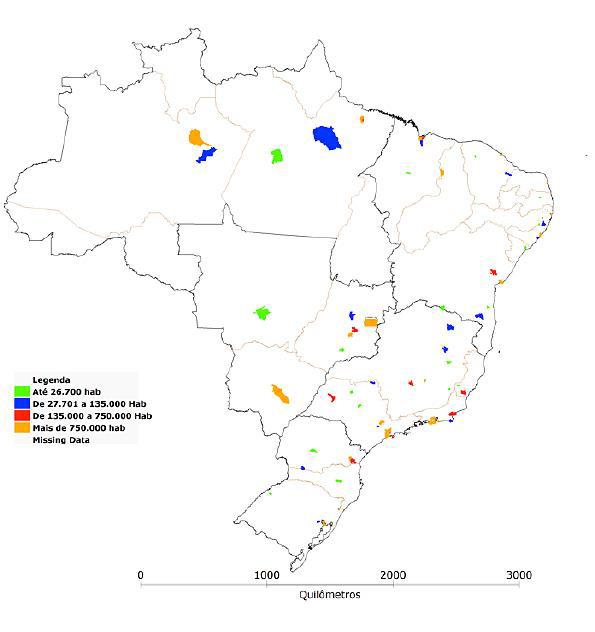Sample Design
The sample was designed to be representative of the community-dwelling Brazilians aged 50 years or older. Due to the lack of a centralized and reliable household registry, Brazil’s national household surveys use the Brazilian Institute of Geography and Statistics (in Portuguese, Instituto Brasileiro de Geografia e Estatística -IBGE) geographic operational base (IBGE, 2010) for stratification and selection of areas for population-based studies. To ensure that the sample represents the urban and rural areas of the small, medium, and large municipalities, the ELSI-Brazil sampling used a design with selection stages, combining stratification of primary sampling units (municipalities), census tracts, and households.
The municipalities were allocated to four strata depending on their population size. To decide the size of the municipality and the number of municipalities allocated to each stratum, the Lavallée and Hidiroglou (1988) method of stratum construction was performed using the module for stratification of the R package (R Foundation for Statistical Computing, Vienna, Austria). The four strata were categorized as follows: first stratum (≤ 26,700 inhabitants from 4,420 municipalities); second stratum (26,701– 135,000 inhabitants from 951 municipalities); third stratum (135,001–750,000 inhabitants from 171 municipalities); and fourth stratum (> 750,000 inhabitants from 23 municipalities). For the first three strata (municipalities up to 750,000 inhabitants), the sample was selected in three stages. In the first stage, 18 municipalities were selected in the first stratum, 15 in the second, and 14 in the third. In the second stage, eight census tracts were selected in each municipality, and finally, the households were selected in each census tract. In the fourth stratum, which included the largest municipalities, the sample selection was done in two stages. In the first stage, 176 census tracts were selected, and in the second stage households were selected. All residents in the selected households aged 50 years or older were eligible for interview and physical measurements.
We used an inverse sampling design to avoid an increase in the sample size to compensate for nonresponses (Vasconcellos et al., 2005). The inverse sampling design enables investigators to define how many units need to be observed in order to obtain a prespecified number of successes, that is, interviews to be performed. Application of this method in ELSI-Brazil consisted of sequentially visiting the previously selected households until reaching the planned number of interviews
The final sample was estimated at 10,000 participants residing in 70 municipalities located across major geographical regions. A sample replacement is expected to occur with each new wave, in order to guarantee the national representativeness of the study population. Figure 1 and Table 1 show the distribution of selected municipalities, according to geographical region and Federation Unit.
Sample weights were derived to account for differential probability of selection and differential nonresponse. Correct use of weights is essential to population inference because the sample is not self-weighting by design. Since ELSI-Brazil has a complex sample design, analyses should account for geographical stratification and clustering in the estimation of standard errors. The mean natural and calibrated weights were: 3,501.6 (standard deviation (SD), 1,695.4) and 4,551.5 (SD, 2,515.9) for the first stratum; 3,568.8 (SD, 2,349.3) and 4,844.9 (SD, 3,464.1) for the second; 4,341.5 (SD, 3,040.1) and 5,706.3 (SD, 4,037.5) for the third; and 2,627.5 (SD, 1,497.5) and 3,573.0 (SD, 2,216.1) for the fourth.
References

Figure 1 – ELSI-Brazil: selected municipalities.
Table 1 – ELSI-Brazil: selected municipalities by geographical region and Federation Unit.
